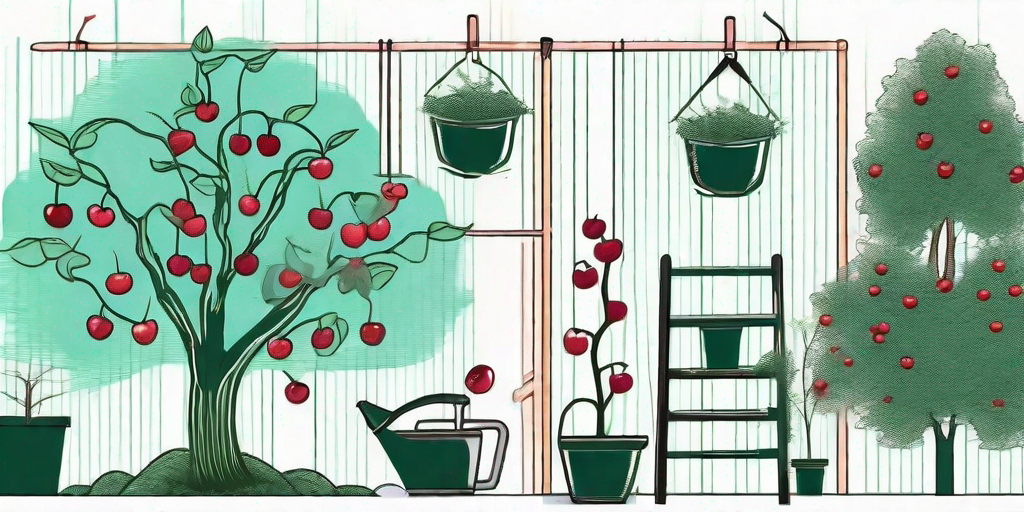
If you've ever found yourself gazing longingly at a cherry tree, dreaming of the day you could have your very own to admire and harvest, then you're in the right place. We're about to embark on a journey of pits, patience, and propagation that will turn you into a bona fide cherry tree whisperer. So, buckle up, green thumbs, and let's get growing!
Understanding the Cherry Tree
Before we dive into the nitty-gritty of cherry tree propagation, it's essential to get to know our subject a little better. Cherry trees are part of the Prunus genus, which also includes plums, peaches, and almonds. But don't let that fool you into thinking they're all the same – each type has its own unique quirks and needs.
Cherry trees come in two main types: sweet and sour. Sweet cherry trees are usually larger and make for great shade trees, while sour cherry trees are smaller and more tolerant of cold weather. So, if you're living in a place where winter is coming every year, a sour cherry tree might be your best bet.
The Importance of Pollination
Now, here's a fun fact: most cherry trees aren't self-pollinating. That means they need a little help from their friends (other cherry trees) to bear fruit. So, if you're planning on growing just one tree, make sure it's a self-pollinating variety, or your dreams of cherry pies might be dashed.
But don't worry, we're not going to leave you hanging. Some self-pollinating varieties include 'Stella', 'Sunburst', and 'Sweetheart'. Remember, it's not just about the name, but the game they bring to your garden.
Propagating Your Cherry Tree
Alright, enough chit-chat. Let's get down to business. Propagating a cherry tree can be done in several ways, but we're going to focus on the two most popular methods: growing from seed and grafting.
Growing from Seed
First things first, you'll need a cherry. Yes, a cherry. It's a tough job, but someone's got to do it. Once you've enjoyed the fruit, clean the pit and let it dry for a few days. Then, it's time for stratification – a fancy term for tricking the seed into thinking it's gone through winter.
Place your pit in a bag with moist peat moss or vermiculite and store it in the fridge for about 10 weeks. After that, plant it in a pot with well-draining soil and wait for the magic to happen. Patience is key here, as it may take several weeks for the seed to germinate.
Grafting
If waiting isn't your strong suit, grafting might be the way to go. This method involves attaching a cutting from a mature cherry tree (the scion) to a young, vigorous rootstock. The result? A cherry tree that's ready to bear fruit in just a few years.
Start by selecting a healthy, disease-free scion and rootstock. Make a clean, diagonal cut on both, then join them together and secure with grafting tape. Keep the grafted tree in a protected area until the graft union heals, then plant it in its permanent location.
Caring for Your Cherry Tree
So, you've successfully propagated your cherry tree. Congratulations! But the journey doesn't end there. Proper care is crucial to ensure your tree grows strong and healthy.
Watering and Feeding
Cherry trees love a good drink, especially during dry periods. Water deeply once a week, making sure the soil is moist but not waterlogged. As for feeding, a balanced slow-release fertilizer applied in early spring should do the trick.
Pruning
Pruning is like a spa day for your cherry tree. It helps to maintain its shape, promote better air circulation, and remove any dead or diseased wood. The best time to prune is in late winter or early spring, when the tree is still dormant.
FAQs
When is the best time to plant a cherry tree?
Spring is the ideal time to plant a cherry tree, as it gives the tree plenty of time to establish its roots before winter arrives. However, if you live in a mild climate, you can also plant in the fall.
How long does it take for a cherry tree to bear fruit?
Depending on the variety and the propagation method, a cherry tree can take anywhere from 3 to 7 years to bear fruit. Patience is indeed a virtue when it comes to cherry tree growing!
Do cherry trees need a lot of sun?
Yes, cherry trees love the sun and need at least 6 hours of direct sunlight each day. So, make sure to choose a sunny spot for your tree.
Conclusion
There you have it, folks! A comprehensive guide to growing your own cherry tree. It might seem like a lot of work, but trust us, the sight of your very own cherry blossoms in spring and the taste of home-grown cherries will make it all worth it. So, what are you waiting for? It's time to get growing!











